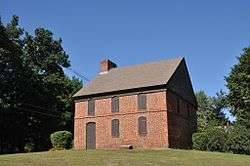Dustin House
|
Dustin House | |
 | |
  | |
| Location | 665 Hilldale Ave., Haverhill, Massachusetts |
|---|---|
| Coordinates | 42°47′47″N 71°6′41″W / 42.79639°N 71.11139°WCoordinates: 42°47′47″N 71°6′41″W / 42.79639°N 71.11139°W |
| Built | c. 1697-8 |
| Architect | Unknown |
| Architectural style | Colonial, Other |
| MPS | First Period Buildings of Eastern Massachusetts TR |
| NRHP reference # | [1] |
| Added to NRHP | March 9, 1990 |
The Dustin House or Dustin Garrison House is a historic First Period house at 665 Hilldale Avenue in Haverhill, Massachusetts. Built about 1700, it is one of a very small number of surviving period houses built out of brick in Massachusetts. It is also notable for its association with the Dustin or Duston family; Hannah Duston was famously captured by Native Americans during a 1697 attack on Haverhill, probably while this house was under construction. The house was added to the National Register of Historic Places in 1990.[1]
Description and history
The Dustin House stands in what is now a rural-residential area of northern Haverhill, on the east side of Hilldale Avenue opposite a golf course. It is set on a rise facing south. It is a 2-1/2 story brick building, with a gabled roof and single end chimney. The main facade is three bays wide, with the entrance set in the leftmost bay. The brick on the facade and east side is laid in Flemish bond, with short-end bricks highlighted by their blackened ends. Window and door openings are topped by segmented arches, and there is a stringcourse of corbelled brickwork between the first and second floors. The brick exhibits patching in a number of places, where openings were once made but afterwards closed during restoration.[2]
The house is believed to have been under construction by farmer and brick-maker Thomas Duston at the time of the 1697 attack on Haverhill during King William's War.[3] It was during this raid that his wife, Hannah Duston, in bed at their existing home a half mile away, was captured by Native Americans. She later wrote a popular captivity narrative about the experience. The Duston house occupied during the raid was demolished c. 1740.
Deed research however, suggests that the Dustins never occupied this house, and that it was probably built for the Kimball family. The house is one of a very small number of brick houses in eastern Massachusetts from the First Period of colonial architecture, and consequently provides an important window into masonry techniques of the period. Its form is also unusual for northeastern Massachusetts, and more closely resembles the stone-enders of early Rhode Island. The building underwent a major restoration in 1946 after its acquisition by a Dustin family association.[2]
See also
References
- 1 2 National Park Service (2008-04-15). "National Register Information System". National Register of Historic Places. National Park Service.
- 1 2 "NRHP nomination and MACRIS inventory record for Dustin House". Commonwealth of Massachusetts. Retrieved 2016-12-20.
- ↑ H. D. Kilgore, "The Story of Hannah Duston" (1940)
